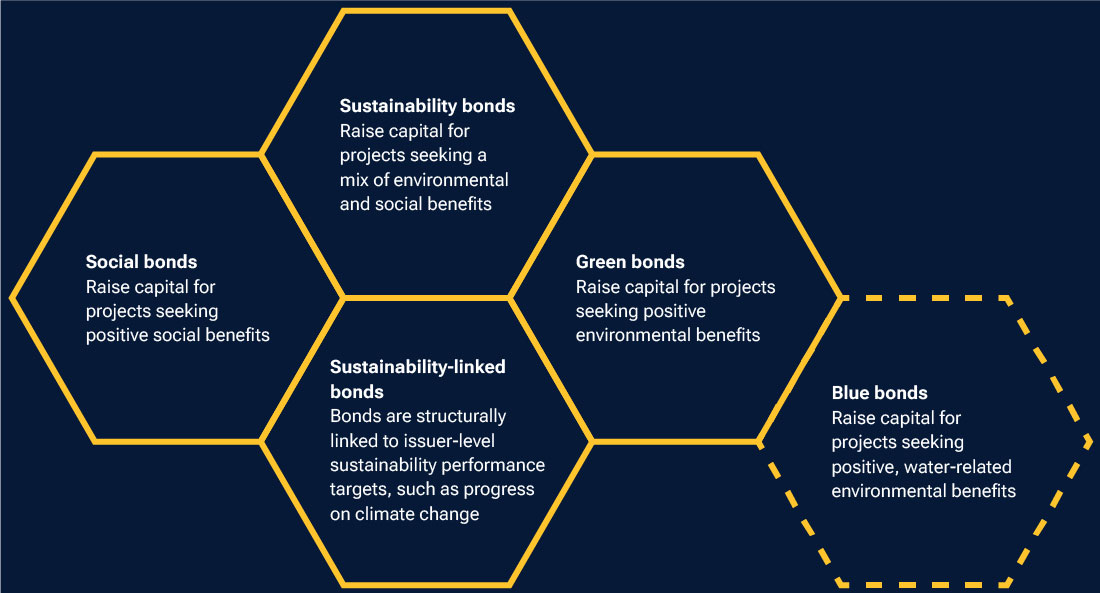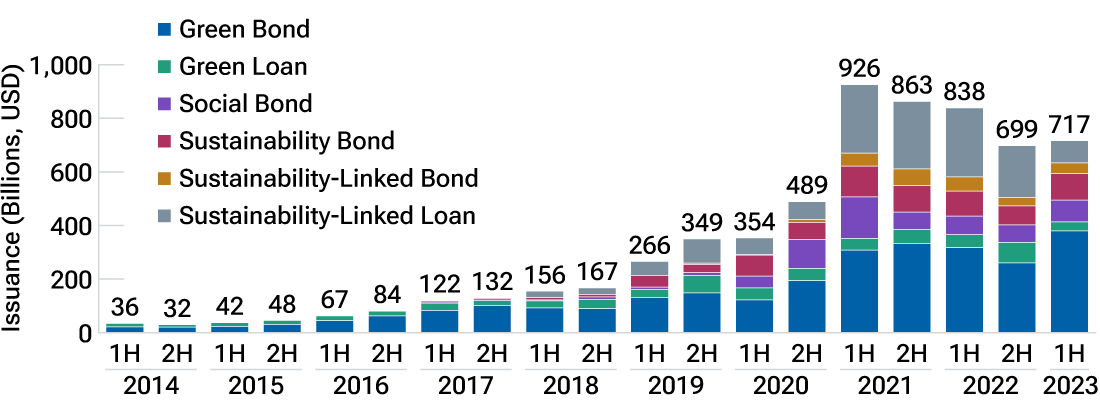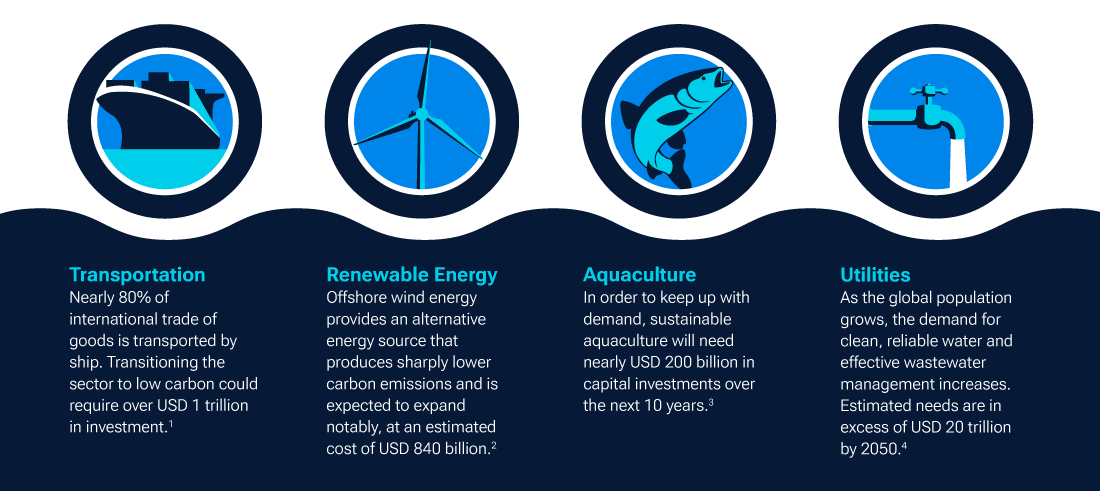December 2023 / INVESTMENT INSIGHTS
Blue Bonds: A Growing Resource for Sustainability Financing
Blue bonds provide financing for ocean-friendly or clean water projects in support of the blue economy.
Key Insights
- Under stress from a variety of sources and severely underfunded, many water resources are in dire need of investment.
- Blue financing could support projects spanning regions, sectors, and asset classes, offering possibilities for fixed income diversification.
- Blue bonds are used exclusively for funding or refinancing ocean‑friendly and other clean water projects.
Issuance of sustainable debt has exploded over the past 10 years as investors seek investment returns by allocating capital toward sustainability efforts. This trend is likely to continue as climate change‑related challenges become increasingly frequent and disruptive, and several governments have responded by deploying increasing amounts of capital to sustainable projects.
Increasing degradation of inland water and ocean ecosystems have created an urgent need for solutions. Blue bonds are becoming an innovative means to finance marine projects as well as for water resource management. Blue financing is an emerging area of sustainable finance, with growing interest from investors and issuers alike. A subset of green financing, blue bonds and loans provide funds for ocean and water resource management projects while green bonds finance a broader set of environmental projects.
To contextualize the cost of ocean decline in economic terms, the United Nations (UN) Environment Programme Finance Initiative estimates that ocean‑linked sectors contribute USD 2.5 trillion in value to the global economy and support over 30 million jobs. Additionally, the ocean provides a vital source of protein to 3 billion people, and its ecosystems are significant mitigators of climate change.
Access to safe, clean, and accessible water is in short supply for billions of people. Shortages are exacerbating agricultural challenges and hindering humanitarian efforts. Meanwhile, oceans generate oxygen, absorb excess heat and carbon emissions produced by human activity, and support vital ecosystems. Yet they are under threat from climate change, pollution, overfishing, and habitat damage, among a host of other pressures.
The sustainable debt market
(Fig. 1) The main types of sustainable debt

As of November 2023.
Source: T. Rowe Price.
Blue bonds in sustainable finance
The sustainable bond market comprises green, blue, social, sustainability, and sustainability‑linked bonds. The sustainable bond market has experienced rapid growth in recent years, both in terms of size, surpassing USD 1 trillion annually, and the breadth of impact themes. Despite this, it remains quite small compared with traditional debt markets. Moreover, the UN has stated that sustainable projects have been underfunded, estimating that a USD 5–7 trillion annual investment is needed to meet Sustainable Development Goals (SDGs), underscoring the urgency and need for additional investment.
Blue bonds could help accelerate the growth of the sustainable bond market while facilitating capital flow to address this funding gap, and recent industry guidance can help investors direct capital toward projects aligned with SDGs. Asset managers, in their role of enabling investors to deploy capital at scale, can act as a catalyst for positive change in the sustainable development and preservation of finite shared water resources.
Frameworks for sustainable projects
All UN members adopted the 17 SDGs in 2015 that defined specific targets to be met by 2030. The SDGs provide a blueprint of global goals to achieve a sustainable future for all. Though progress has been slow, issuance of investments aligned with SDGs has picked up.
Importantly, the International Finance Corporation, a member of the World Bank Group, generated guidelines for blue finance, building on the International Capital Markets Association’s principles and guidelines for sustainable bond issuance. These guidelines help to inform issuers and investors alike about expectations to be met to use the blue bond label and avoid the potential for “bluewashing”—the inadvertent or intentional misrepresentation of the blue and broader sustainability characteristics of a financial product and/or of the sustainable commitments and/or achievements of an issuer. Currently, the vast majority of labeled sustainable bonds align with these guidelines. Blue bonds and loans are used exclusively for financing ocean‑friendly or clean water projects. Sovereigns, development banks, quasi‑sovereigns, and corporate issuers, among others, can finance projects that align with UN SDG 6 (clean water and sanitation) and SDG 14 (life below water) via blue bonds or loans.
The sustainable debt market has increased
(Fig. 2) Annual sustainable debt issuance by instrument type

As of June 30, 2023.
Sources: BloombergNEF and Bloomberg Finance L.P.
Water resource pressure points
A variety of challenges—chiefly water scarcity, pollution and degradation, and risks to marine ecosystems—are stressing global water resources and limiting global growth.
Water scarcity
While water covers over 70% of the Earth’s surface, increasing demand and unpredictable supply have led to significant accessibility challenges for an estimated 2 billion people. Clean water is essential to health, food security, poverty reduction, and economic stability.
Additionally, climate change has exacerbated the unpredictability of water availability, spurring water management challenges globally. The impacts of water scarcity are made worse by pollution contaminating water sources, making it unusable for many purposes. Pollution from oil spills, the shipping industry, chemical and industrial waste, and runoff from agriculture are degrading the marine ecosystem. Trash, notably from plastic, is another form of pollution. The World Bank estimates that USD 114 billion is needed each year through 2030 to achieve its clean water goal (SD6).
Biodiversity
The severe deterioration of biodiversity—the forms of life in an ecosystem—is in part evidenced by the rapid acceleration in the extinction of species. We believe that preserving biodiversity is essential to the long‑term social and economic development of humanity and that biodiversity loss and climate change are fundamentally interlinked twin crises. The UN included SDG 14 (life below water) in response to concerns about stress on marine ecosystems. To date, it is the least funded SDG.
Oceans are the world’s largest natural carbon sinks, which can absorb more carbon than they produce. Carbon sinks play a key role in controlling climate change as they absorb significant amounts of human‑generated greenhouse gas emissions. By absorbing carbon from the atmosphere, the ocean is growing more acidic and directly harming some marine animals.
Addressing pressure points
The blue economy comprises activities associated with preserving the ocean and using them in a sustainable way to develop economies and improve livelihoods. Blue bonds may provide a tool for investors seeking to contribute to better environmental outcomes. As with any fixed income investment, blue bonds carry investment risks, which include credit risk and interest rate risk. In addition, emerging markets are less established than developed markets and therefore involve higher risks.
The world’s policymakers, governments, investors, and individuals alike all have an important role to play in the blue economy. The finance industry can provide some of the much‑needed capital through innovative solutions such as blue bonds to help support and enhance ocean sustainability, mitigate against the threats of climate change, and improve access to clean water. These projects historically have been underfunded. As the urgency to face these struggles increases, so, too, does the need for investment. While a nascent market today, blue bonds offer an opportunity for investors seeking to diversify their portfolios and invest directly in issuers and projects seeking to generate positive and measurable impact.
While blue bonds can support projects anywhere, we see heightened pressures in developing economies where capital is most scarce, spanning regions and sectors. Northern Africa and Western Asia are water‑stressed regions, while Latin America’s needs are more focused on aquaculture and agriculture, and Asia must contend with elevated levels of plastic pollution.
In addition to regional considerations, projects that support water resources and can be financed using blue bonds and loans span many sectors.
How blue bonds support the blue economy
(Fig. 3) Estimated costs of identified activities to support water resources by sector.

1 Source: UNCTAD (2023).
2 Source: International Energy Agency (2019).
3 Source: Nature Conservancy (2019).
4 Source: World Water Council and OECD (2015).
IMPORTANT INFORMATION
This material is being furnished for general informational and/or marketing purposes only. The material does not constitute or undertake to give advice of any nature, including fiduciary investment advice, nor is it intended to serve as the primary basis for an investment decision. Prospective investors are recommended to seek independent legal, financial and tax advice before making any investment decision. T. Rowe Price group of companies including T. Rowe Price Associates, Inc. and/or its affiliates receive revenue from T. Rowe Price investment products and services. Past performance is not a reliable indicator of future performance. The value of an investment and any income from it can go down as well as up. Investors may get back less than the amount invested.
The material does not constitute a distribution, an offer, an invitation, a personal or general recommendation or solicitation to sell or buy any securities in any jurisdiction or to conduct any particular investment activity. The material has not been reviewed by any regulatory authority in any jurisdiction.
Information and opinions presented have been obtained or derived from sources believed to be reliable and current; however, we cannot guarantee the sources' accuracy or completeness. There is no guarantee that any forecasts made will come to pass. The views contained herein are as of the date noted on the material and are subject to change without notice; these views may differ from those of other T. Rowe Price group companies and/or associates. Under no circumstances should the material, in whole or in part, be copied or redistributed without consent from T. Rowe Price.
The material is not intended for use by persons in jurisdictions which prohibit or restrict the distribution of the material and in certain countries the material is provided upon specific request.
It is not intended for distribution to retail investors in any jurisdiction.


